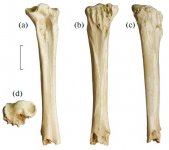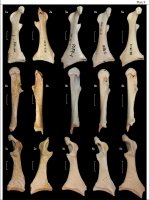Fred Ruhe
Well-known member

Natalia V. Volkova & Nikita V. Zelenkov, 2020
К РАЗНООБРАЗИЮ И МОРФОЛОГИИ ANSERINI (AVES: ANATIDAE) ПОЗДНЕГО МИОЦЕНА ЗАПАДНОЙ МОНГОЛИИ
On the diversity and morphology of Anserini (Aves: Anatidae) from the late Miocene of western Mongolia
Paleontological Journal. 54 in press
Abstract: https://elibrary.ru/item.asp?id=41695143
Описаны ранее не изученные кости гусей (два коракоида и тарсометатарсус) из местонахождения Хиргис-Нур 2 (поздний миоцен Западной Монголии). Впервые отнесенный к Anser devjatkini Kurochkin, 1971 тарсометатарсус указывает на филогенетическую близость этого вымершего вида современным серым гусям; отмеченное ранее сходство с белыми гусями по другим элементам скелета трактуется как плезиоморфное. Морфологический переход от белых к серым гусям сопровождался изменением локомоторных специализаций задней конечности (соотношение адаптации к плаванию и бегу). Два коракоида морфологически отличаются от таковых современных Anser и Branta, но сходны с “Branta” woolfendeni Bickart, 1990 из позднего миоцена Аризоны (США), от которого отличаются крупными размерами. Эти находки представляют отдельный род гусиных, широко распространенный в позднем миоцене Азии и Северной Америки. Обсуждается эволюция и палеогеография гусиных в позднем миоцене. Богатое разнообразие гусиных на местонахождении Хиргис-Нур 2 (не менее 3–4 видов) может объясняться зимовкой этих птиц на крупных водоемах Центральной Азии.
ANSERINI, ЭВОЛЮЦИЯ, ANSER DEVJATKINI, BRANTA WOOLFENDENI, НЕОГЕН, ПОЗДНИЙ МИОЦЕН, МОНГОЛИЯ, EVOLUTION, NEOGENE, LATE MIOCENE, MONGOLIA
When the english version of this paper is there, I will come back on it.
Enjoy,
Fred
К РАЗНООБРАЗИЮ И МОРФОЛОГИИ ANSERINI (AVES: ANATIDAE) ПОЗДНЕГО МИОЦЕНА ЗАПАДНОЙ МОНГОЛИИ
On the diversity and morphology of Anserini (Aves: Anatidae) from the late Miocene of western Mongolia
Paleontological Journal. 54 in press
Abstract: https://elibrary.ru/item.asp?id=41695143
Описаны ранее не изученные кости гусей (два коракоида и тарсометатарсус) из местонахождения Хиргис-Нур 2 (поздний миоцен Западной Монголии). Впервые отнесенный к Anser devjatkini Kurochkin, 1971 тарсометатарсус указывает на филогенетическую близость этого вымершего вида современным серым гусям; отмеченное ранее сходство с белыми гусями по другим элементам скелета трактуется как плезиоморфное. Морфологический переход от белых к серым гусям сопровождался изменением локомоторных специализаций задней конечности (соотношение адаптации к плаванию и бегу). Два коракоида морфологически отличаются от таковых современных Anser и Branta, но сходны с “Branta” woolfendeni Bickart, 1990 из позднего миоцена Аризоны (США), от которого отличаются крупными размерами. Эти находки представляют отдельный род гусиных, широко распространенный в позднем миоцене Азии и Северной Америки. Обсуждается эволюция и палеогеография гусиных в позднем миоцене. Богатое разнообразие гусиных на местонахождении Хиргис-Нур 2 (не менее 3–4 видов) может объясняться зимовкой этих птиц на крупных водоемах Центральной Азии.
ANSERINI, ЭВОЛЮЦИЯ, ANSER DEVJATKINI, BRANTA WOOLFENDENI, НЕОГЕН, ПОЗДНИЙ МИОЦЕН, МОНГОЛИЯ, EVOLUTION, NEOGENE, LATE MIOCENE, MONGOLIA
When the english version of this paper is there, I will come back on it.
Enjoy,
Fred
Last edited:





